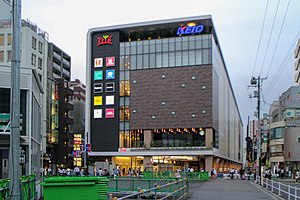Chōfu Station (Tokyo)
Chōfu Station 調布駅 | |
|---|---|
 Chōfu Station building, October 2017 | |
| Location | 4-32-1 Fuda, Chōfu-shi, Tokyo 182-0024 Japan |
| Coordinates | 35°39′08″N 139°32′39″E / 35.6521659°N 139.5440376°ECoordinates: 35°39′08″N 139°32′39″E / 35.6521659°N 139.5440376°E |
| Operated by | |
| Line(s) |
|
| Distance | 15.5 km from Shinjuku |
| Platforms | 2 island platforms |
| Other information | |
| Station code | KO18 |
| Website | Official website |
| History | |
| Opened | April 15, 1913 |
| Passengers | |
| 2019 | 130,065 (daily) |
| Location | |
 Chōfu Station Location within Tokyo | |


Chōfu Station (調布駅, Chōfu-eki) is a junction passenger railway station located in the city of Chōfu, Tokyo, Japan, operated by the private railway operator Keio Corporation.[1]
Lines[]
Chōfu Station is served by the Keio Line and Keiō Sagamihara Line as the junction of the two lines. It is located 15.5 kilometers from the starting point of the Keio Line at Shinjuku Station and is a terminus of the 22.6 kilometer Sagamihara Line.
Station layout[]
This station has two underground island platforms in the second basement (Tracks 1 and 2) and the third basement (Tracks 3 and 4). Ticket windows and gates are in the first basement.[2]
Platforms[]
| 1, 2 | ■ Keio Sagamihara Line | Hashimoto |
| ■ Keiō Line | Keiō Hachiōji, Takaosanguchi, Tama-Dōbutsu-kōen | |
| 3, 4 | ■ Keiō Line | Meidaimae, Sasazuka, Shinjuku, the Toei Shinjuku Line (including trains from the Sagamihara Line for Shinjuku and the Toei Shinjuku Line) |
History[]
The station opened on April 15, 1913 when Keiō Electric Tramway opened its first section between Sasazuka and Chōfu.[3]
Recent development[]
Until 2012, Chofu Station was on the ground level and had busy grade crossings at either end for road traffic, while trains arriving from the Keio Sagamihara Line blocked both lines of the Keio Line as they enter the station. Keio Corporation resolved both these issues by grade separation of railway lines around the station area. Underground tracks opened on August 19, 2012.[4]
Adjacent stations[]
| « | Service | » | ||
|---|---|---|---|---|
| Keiō Line | ||||
| Keiō Liner: Does not stop at this station | ||||
| Meidaimae | Special Express | Fuchū | ||
| Chitose-karasuyama | Semi Special Express | Fuchū (Higashi-Fuchū) | ||
| Tsutsujigaoka | Express | Higashi-Fuchū | ||
| Tsutsujigaoka | Semi Express | Higashi-Fuchū | ||
| Tsutsujigaoka | Rapid | Nishi-Chōfu | ||
| Fuda | Local | Nishi-Chōfu | ||
| Keiō Sagamihara Line | ||||
| Keiō Liner: Does not stop at this station | ||||
| Through service to Keiō Line |
Special Express | Keio Inadazutsumi | ||
| Through service to Keiō Line |
Semi Special Express | Keio Inadazutsumi | ||
| Through service to Keiō Line |
Express | Keio Inadazutsumi | ||
| Through service to Keiō Line |
Semi Express | Keiō Tamagawa | ||
| Through service to Keiō Line |
Rapid | Keiō Tamagawa | ||
| Through service to Keiō Line |
Local | Keiō Tamagawa | ||
Passenger statistics[]
In fiscal 2019, the station was used by an average of 130,065 passengers daily.[5]
The passenger figures (boarding passengers only) for previous years are as shown below.
| Fiscal year | daily average |
|---|---|
| 2005 | 109,956[6] |
| 2010 | 114,906[7] |
| 2015 | 117,781[8] |
Surrounding area[]
- Chōfu City Hall
- Chōfu Tenjin Shrine
- University of Electro-Communications
See also[]
References[]
- ^ Keio Railway Map
- ^ "Station information by Keio Corporation" (PDF) (in Japanese). Retrieved August 19, 2012.
- ^ Keio Corporation. "京王の電車・バス開業100周年年表". Retrieved April 29, 2014.
- ^ 京王電鉄2区間が地下線で運転開始 調布駅付近で切り替え工事完了 (in Japanese). MSN Sankei News. August 19, 2012. Archived from the original on August 23, 2012. Retrieved August 19, 2012.
- ^ 1日の駅別乗降人員 [Station passenger figures (Fiscal 2019)] (in Japanese). Japan: Keio Railway Company. Retrieved 29 January 2021.
- ^ 東京都統計年鑑 平成17年 9 運輸及び通信 [Tokyo Metropolitan Government statistics (fiscal 2005)] (in Japanese). Japan: Tokyo Metropolitan Government. Retrieved 26 March 2021.
- ^ 東京都統計年鑑 平成22年 [Tokyo Metropolitan Government statistics (fiscal 2010)] (in Japanese). Japan: Tokyo Metropolitan Government. Retrieved 26 March 2021.
- ^ 東京都統計年鑑 平成27年 9 運輸及び通信 [Tokyo Metropolitan Government statistics (fiscal 2010)] (in Japanese). Japan: Tokyo Metropolitan Government. Retrieved 26 March 2021.
External links[]
![]() Media related to Chōfu Station (Tokyo) at Wikimedia Commons
Media related to Chōfu Station (Tokyo) at Wikimedia Commons
- Keio Railway Station Information (in Japanese)
- Stations of Keio Corporation
- Keio Line
- Keio Sagamihara Line
- Railway stations in Japan opened in 1913
- Railway stations in Tokyo
- Chōfu, Tokyo

